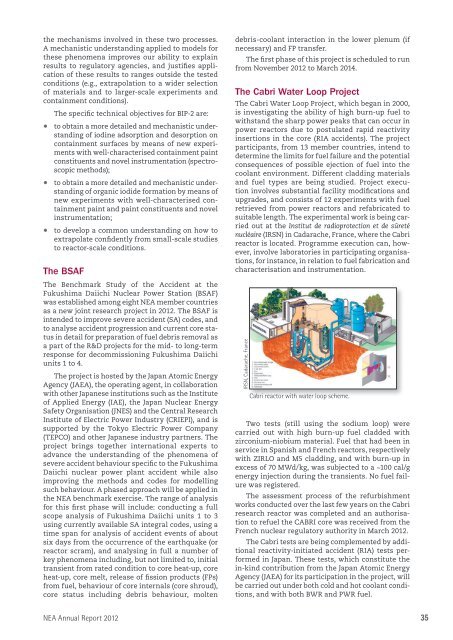Download the report in pdf format - OECD Nuclear Energy Agency
Download the report in pdf format - OECD Nuclear Energy Agency
Download the report in pdf format - OECD Nuclear Energy Agency
Create successful ePaper yourself
Turn your PDF publications into a flip-book with our unique Google optimized e-Paper software.
<strong>the</strong> mechanisms <strong>in</strong>volved <strong>in</strong> <strong>the</strong>se two processes.<br />
A mechanistic understand<strong>in</strong>g applied to models for<br />
<strong>the</strong>se phenomena improves our ability to expla<strong>in</strong><br />
results to regulatory agencies, and justifies application<br />
of <strong>the</strong>se results to ranges outside <strong>the</strong> tested<br />
conditions (e.g., extrapolation to a wider selection<br />
of materials and to larger-scale experiments and<br />
conta<strong>in</strong>ment conditions).<br />
The specific technical objectives for BIP-2 are:<br />
• to obta<strong>in</strong> a more detailed and mechanistic understand<strong>in</strong>g<br />
of iod<strong>in</strong>e adsorption and desorption on<br />
conta<strong>in</strong>ment surfaces by means of new experiments<br />
with well-characterised conta<strong>in</strong>ment pa<strong>in</strong>t<br />
constituents and novel <strong>in</strong>strumentation (spectroscopic<br />
methods);<br />
• to obta<strong>in</strong> a more detailed and mechanistic understand<strong>in</strong>g<br />
of organic iodide <strong>format</strong>ion by means of<br />
new experiments with well-characterised conta<strong>in</strong>ment<br />
pa<strong>in</strong>t and pa<strong>in</strong>t constituents and novel<br />
<strong>in</strong>strumentation;<br />
• to develop a common understand<strong>in</strong>g on how to<br />
extrapolate confidently from small-scale studies<br />
to reactor-scale conditions.<br />
The BSAF<br />
The Benchmark Study of <strong>the</strong> Accident at <strong>the</strong><br />
Fukushima Daiichi <strong>Nuclear</strong> Power Station (BSAF)<br />
was established among eight NEA member countries<br />
as a new jo<strong>in</strong>t research project <strong>in</strong> 2012. The BSAF is<br />
<strong>in</strong>tended to improve severe accident (SA) codes, and<br />
to analyse accident progression and current core status<br />
<strong>in</strong> detail for preparation of fuel debris removal as<br />
a part of <strong>the</strong> R&D projects for <strong>the</strong> mid- to long-term<br />
response for decommission<strong>in</strong>g Fukushima Daiichi<br />
units 1 to 4.<br />
The project is hosted by <strong>the</strong> Japan Atomic <strong>Energy</strong><br />
<strong>Agency</strong> (JAEA), <strong>the</strong> operat<strong>in</strong>g agent, <strong>in</strong> collaboration<br />
with o<strong>the</strong>r Japanese <strong>in</strong>stitutions such as <strong>the</strong> Institute<br />
of Applied <strong>Energy</strong> (IAE), <strong>the</strong> Japan <strong>Nuclear</strong> <strong>Energy</strong><br />
Safety Organisation (JNES) and <strong>the</strong> Central Research<br />
Institute of Electric Power Industry (CRIEPI), and is<br />
supported by <strong>the</strong> Tokyo Electric Power Company<br />
(TEPCO) and o<strong>the</strong>r Japanese <strong>in</strong>dustry partners. The<br />
project br<strong>in</strong>gs toge<strong>the</strong>r <strong>in</strong>ternational experts to<br />
advance <strong>the</strong> understand<strong>in</strong>g of <strong>the</strong> phenomena of<br />
severe accident behaviour specific to <strong>the</strong> Fukushima<br />
Daiichi nuclear power plant accident while also<br />
improv<strong>in</strong>g <strong>the</strong> methods and codes for modell<strong>in</strong>g<br />
such behaviour. A phased approach will be applied <strong>in</strong><br />
<strong>the</strong> NEA benchmark exercise. The range of analysis<br />
for this first phase will <strong>in</strong>clude: conduct<strong>in</strong>g a full<br />
scope analysis of Fukushima Daiichi units 1 to 3<br />
us<strong>in</strong>g currently available SA <strong>in</strong>tegral codes, us<strong>in</strong>g a<br />
time span for analysis of accident events of about<br />
six days from <strong>the</strong> occurrence of <strong>the</strong> earthquake (or<br />
reactor scram), and analys<strong>in</strong>g <strong>in</strong> full a number of<br />
key phenomena <strong>in</strong>clud<strong>in</strong>g, but not limited to, <strong>in</strong>itial<br />
transient from rated condition to core heat-up, core<br />
heat-up, core melt, release of fission products (FPs)<br />
from fuel, behaviour of core <strong>in</strong>ternals (core shroud),<br />
core status <strong>in</strong>clud<strong>in</strong>g debris behaviour, molten<br />
debris-coolant <strong>in</strong>teraction <strong>in</strong> <strong>the</strong> lower plenum (if<br />
necessary) and FP transfer.<br />
The first phase of this project is scheduled to run<br />
from November 2012 to March 2014.<br />
The Cabri Water Loop Project<br />
The Cabri Water Loop Project, which began <strong>in</strong> 2000,<br />
is <strong>in</strong>vestigat<strong>in</strong>g <strong>the</strong> ability of high burn-up fuel to<br />
withstand <strong>the</strong> sharp power peaks that can occur <strong>in</strong><br />
power reactors due to postulated rapid reactivity<br />
<strong>in</strong>sertions <strong>in</strong> <strong>the</strong> core (RIA accidents). The project<br />
participants, from 13 member countries, <strong>in</strong>tend to<br />
determ<strong>in</strong>e <strong>the</strong> limits for fuel failure and <strong>the</strong> potential<br />
consequences of possible ejection of fuel <strong>in</strong>to <strong>the</strong><br />
coolant environment. Different cladd<strong>in</strong>g materials<br />
and fuel types are be<strong>in</strong>g studied. Project execution<br />
<strong>in</strong>volves substantial facility modifications and<br />
upgrades, and consists of 12 experiments with fuel<br />
retrieved from power reactors and refabricated to<br />
suitable length. The experimental work is be<strong>in</strong>g carried<br />
out at <strong>the</strong> Institut de radioprotection et de sûreté<br />
nucléaire (IRSN) <strong>in</strong> Cadarache, France, where <strong>the</strong> Cabri<br />
reactor is located. Programme execution can, however,<br />
<strong>in</strong>volve laboratories <strong>in</strong> participat<strong>in</strong>g organisations,<br />
for <strong>in</strong>stance, <strong>in</strong> relation to fuel fabrication and<br />
characterisation and <strong>in</strong>strumentation.<br />
IRSN, Cadarache, France<br />
Cabri reactor with water loop scheme.<br />
Two tests (still us<strong>in</strong>g <strong>the</strong> sodium loop) were<br />
carried out with high burn-up fuel cladded with<br />
zirconium-niobium material. Fuel that had been <strong>in</strong><br />
service <strong>in</strong> Spanish and French reactors, respectively<br />
with ZIRLO and M5 cladd<strong>in</strong>g, and with burn-up <strong>in</strong><br />
excess of 70 MWd/kg, was subjected to a ~100 cal/g<br />
energy <strong>in</strong>jection dur<strong>in</strong>g <strong>the</strong> transients. No fuel failure<br />
was registered.<br />
The assessment process of <strong>the</strong> refurbishment<br />
works conducted over <strong>the</strong> last few years on <strong>the</strong> Cabri<br />
research reactor was completed and an authorisation<br />
to refuel <strong>the</strong> CABRI core was received from <strong>the</strong><br />
French nuclear regulatory authority <strong>in</strong> March 2012.<br />
The Cabri tests are be<strong>in</strong>g complemented by additional<br />
reactivity-<strong>in</strong>itiated accident (RIA) tests performed<br />
<strong>in</strong> Japan. These tests, which constitute <strong>the</strong><br />
<strong>in</strong>-k<strong>in</strong>d contribution from <strong>the</strong> Japan Atomic <strong>Energy</strong><br />
<strong>Agency</strong> (JAEA) for its participation <strong>in</strong> <strong>the</strong> project, will<br />
be carried out under both cold and hot coolant conditions,<br />
and with both BWR and PWR fuel.<br />
NEA Annual Report 2012<br />
35
















